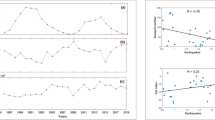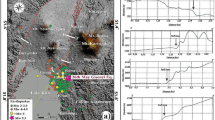Abstract
In this study, we accurately relocate 360 earthquakes in the Sikkim Himalaya through the application of the double-difference algorithm to 4 years of data accrued from a eleven-station broadband seismic network. The analysis brings out two major clusters of seismicity—one located in between the main central thrust (MCT) and the main boundary thrust (MBT) and the other in the northwest region of Sikkim that is site to the devastating Mw6.9 earthquake of September 18, 2011. Keeping in view the limitations imposed by the Nyquist frequency of our data (10 Hz), we select 9 moderate size earthquakes (5.3 ≥ Ml ≥ 4) for the estimation of source parameters. Analysis of shear wave spectra of these earthquakes yields seismic moments in the range of 7.95 × 1021 dyne-cm to 6.31 × 1023 dyne-cm and corner frequencies in the range of 1.8–6.25 Hz. Smaller seismic moments obtained in Sikkim when compared with the rest of the Himalaya vindicates the lower seismicity levels in the region. Interestingly, it is observed that most of the events having larger seismic moment occur between MBT and MCT lending credence to our observation that this is the most active portion of Sikkim Himalaya. The estimates of stress drop and source radius range from 48 to 389 bar and 0.225 to 0.781 km, respectively. Stress drops do not seem to correlate with the scalar seismic moments affirming the view that stress drop is independent over a wide moment range. While the continental collision scenario can be invoked as a reason to explain a predominance of low stress drops in the Himalayan region, those with relatively higher stress drops in Sikkim Himalaya could be attributed to their affinity with strike-slip source mechanisms. Least square regression of the scalar seismic moment (M 0) and local magnitude (Ml) results in a relation LogM 0 = (1.56 ± 0.05)Ml + (8.55 ± 0.12) while that between moment magnitude (M w ) and local magnitude as M w = (0.92 ± 0.04)Ml + (0.14 ± 0.06). These relations could serve as useful inputs for the assessment of earthquake hazard in this seismically active region of Himalaya.











Similar content being viewed by others
References
Abercrombie RE (1995) Earthquake source scaling relationship from −1 to 5 ML using seismograms recorded at 2.5-km depth. J Geophys Res 100:24015–24036
Aki K (1967) Scaling law of seismic spectrum. Bull Seismol Soc Am 72:1217–1231
Aki K, Richards PG (2002) Quantitative seismology, 2nd edn. University Science Books, Sausalito, CA
Allen I, Trevor Gibson G, Brown A, Cull JP (2004) Depth variation of seismic source scaling relations: implications for earthquake hazard in southeastern Australia. Tectonophysics 390:5–24
Allmann BP, Shearer PM (2009) Global variation of stress drop for moderate to large earthquakes. J Geophys Res 114:B-131. doi:10.1029/2008JB005821
Andrews DJ (1986) Objective determination of source parameters and similarity of earthquakes of different size. In: Das et al. (Eds) Earthquake source mechanics. Ewing Series, 6, AGU, Washington DC www1986, pp 259–267
Archuleta RJ, Cranswick E, Mueller C, Spudich P (1982) Source parameters of the 1980 Mammoth Lakes. California, earthquake sequence. J Geophys Res 87:4595–4607
Baltay A, Ide S, Prieto G, Beroza G (2011) Variability in earthquake stress drop and apparent stress. Geophys Res Lett 38:L06303. doi:10.1029/2011GL046698
Bansal BK (1998) Determination of source parameters for small earthquake in the Koyna region, 11th symposium on earthquake engineering. Roorkee 1:57–66
Boatwright J (1980) A spectral theory for seismic sources: simple estimates of source dimension, dynamic stress drop and radiator energy. Bull Seism Soc Am 70:1–27
Boore DM, Campbell WC, Atkinson GM (2010) Determination of stress parameters for eight well-recorded earthquakes in Eastern North America. Bull Seism Soc Am 100:1632–1645. doi:10.1785/0120090328
Brune JN (1970) Tectonic stress and seismic shear waves from earthquakes. J Geophys Res 75:4997–5009
Brune JN (1971) Correction. J Geophys Res 76:5002
Chevrot S, Cansi Y (1996) Source spectra and site-response estimates using the coda of Lg waves in western Europe. Geophys Res Lett 23:1605–1608
Chouliaras G, Stavrakakis GN (1997) Seismic source parameters from a new dial-up seismological network in Greece. Pure Appl Geophys 150:91–111
Cotte N, Pedersen H, Campillo M, Mars J, Ni J, Kind R, Sandvol E, Zhao W (1999) Determination of the crustal structure in Southern Tibet by dispersion and amplitude analysis of Rayleigh waves. Geophys J Int 138:809–819
Deichmann N (2006) Local magnitude. A moment revisited. Bull Seism Soc Am 96:1267–1277. doi:10.1785/0120050115
Drouet S, Souriau A, Cotton F (2005) Attenuation, seismic moment, and site effects for weak-motion events: application to the Pyrenees. Bull Seismol Soc Am 95(5):1731–1748
Drouet S, Chevrot S, Cotton F, Souriau A (2008) Simultaneous Inversion of Source Spectra, Attenuation Parameters and Site Responses: Application to the data of the French Accelerometric Network. Bull Seism Soc Am 98:198–219. doi:10.1785/0120060215
Drukpa D, Velasco AA, Doser DI (2006) Seismicity in the Kingdom of Bhutan (1937–2003): evidence for crustal transcurrent deformation. J Geophys Res B Solid Earth Planets 111:B06301
Eshelby J (1957) The determination of the elastic field of an ellipsoidal inclusion and related problems. Proc R Soc Lond A 241:376–396
Fletcher JB (1980) A comparison between high-dynamic range digital recordings of Oroville, California aftershocks and their source parameters. Bull Seism Soc Am 70:735–755
Fletcher JB, Boatwright J, Harr L, Hanks T, McGarr A (1984) Source parameters for aftershocks of the Oroville, California earthquake. Bull Seism Soc Am 74:1101–1123
GSI (2000) Seismotectonic Atlas of India and its environs
Gupta DI, Rambabu V (1993) Source parameters of some significant earthquakes near Koyna Dam, India. Pageop 140:403–413
Gupta HK, Singh DD (1980) Spectral analysis of body waves for earthquakes in Nepal Himalaya and vicinity: their focal parameters and tectonic implications. Tectonophysics 62:53–66
Hanks TC, Boore DM (1984) Moment-Magnitude relations in theory and practice. J Geophys Res 89:6229–6235
Hanks TC, Kanamori H (1979) A moment magnitude scale. J Geophys Res 84:2348–2350
Havskov J, Ottemöller L (2003) SEISAN: the earthquake analysis software, version 8.0, Institute of Solid Earth Physics, University of Bergen, Bergen, Norway
Hazarika P, Kumar MR, Srijayanthi G, Raju PS, Rao NP, Srinagesh D (2010) Transverse Tectonics in Sikkim Himalaya: evidences from seismicity and focal mechanism data. Bull Seism Soc Am 100:1816–1822. doi:10.1785/0120090339
Herrmann RB, Kijko A (1983) Modelling some empirical vertical component Lg relations. Bull Seismol Soc Am 75:157–171
Hiramatsu Y, Yamanaka H, Tadokoro K, Nishigami K, Ohmi S (2002) Scaling law between corner frequency and seismic moment of microearthquakes: is the breakdown of cube law a nature of earthquake? Geophys Res Lett 29:1211. doi:10.1029/2001GL013894
Hough SE (1996) Observational constraints on earthquake source scaling: understanding the limits in resolution. Tectonophysics 261:83–95
Johnson LR, McEvilly TV (1974) Near field observations and source parameters of Central California earthquakes. Bull Seismol Soc Am 64:1855–1886
Kato N (2009) A possible explanation for difference in stress drop between intraplate and interplate earthquakes. Geophys Res Lett 36:L23311. doi:10.1029/2009GL040985
Kayal JR, Baruah S, Baruah S, Gautam JL, Arefiev SS, Tatevossian R (2011) The September 2011 Sikkim deeper centroid Mw 6.9 earthquake: role of transverse faults in eastern Himalaya, DCS-DST News
Kim WY, Wahlstrom R, Uski M (1989) Regional spectral scaling relations of source parameters for earthquakes in the Baltic Shield. Tectonophysics 166:151–161
Kumar D, Ram VS, Khattri KN (2006) A study of source parameters, site amplification functions and average effective shear wave quality factor qseff from analysis of accelerograms of the 1999 Chamoli earthquake, Himalaya. Pure Appl Geophys 163:1369–1398
Kumar D, Sarkar I, Sriram V, Khattri KN (2005) Estimation of the source parameters of the Himalaya earthquake of October 19, 1991, average effective shear wave attenuation parameter and local site effects from accelerograms. Tectonophysics 407:1–24
Mandal PK, Rastogi BK, Sarma CSP (1998) Source parameters of Koyna earthquakes, India. Bull Seism Soc Am 88:833–842
Mayeda K, Malagnini L, Walter WR (2007) A new spectral ratio method using narrow band coda envelopes: evidence for non-self-similarity in the Hector Mine sequence. Geophys Res Lett 34:L11303. doi:10.1029/2007GL030041
O’Neill ME (1984) Source dimension and stress drops of small earthquakes near Parkfield, California. Bull Seism Soc Am 71:27–40
Ottemoller L, Havskov J (2003) Moment magnitude determination for local and regional earthquakes based on source spectra. Bull Seism Soc Am 93:203–214
Pearson C (1982) Parameters and a magnitude moment relationship for small earthquakes observed during hydraulic fracturing experiments in crystalline rocks. Geophys Res Lett 9:404–407
Prieto GA, Shearer PM, Vernon FL, Kilb D (2004) Earthquake source scaling and self-similarity estimation from stacking P and S spectra. J Geophys Res 109:B08310. doi:10.1029/2004JB003084
Raj A, Nath SK, Bansal BK, Thingbaijam KKS, Kumar A, Thiruvengadam N, Yadav A, Arrawatia ML (2009) Rapid estimation of source parameters using finite fault modeling-Case studies from the Sikkim and Garhwal Himalayas. Seism Res Lett 80(1):89–96
Rajendran K, Rajendran CP, Thulasiraman N, Andrews R, Sherpa N (2011) The 18 September, North Sikkim earthquake: a preliminary report. Curr Sci 101:1475–1479
Ram VS, Kumar D, Khattri KN (2005) The 1986 Dharamsala earthquake of Himachal Himalaya – estimates of source parameters, average intrinsic attenuation and site amplification functions. J Seismol 9:473–485
Sharma ML, Wason HR (1994) Occurrence of low stress drop earthquakes in the Garhwal Himalaya region. Phys Earth Planet Inter 85:265–722
Shi J, Kim WY, Richards PG (1998) The corner frequencies and stress drops of intraplate earthquakes in the Northeastern United States. Bull Seism Soc Am 88:531–542
Singh DD, Rastogi BK, Gupta HK (1978) Spectral analysis of body waves for earthquakes and their source parameters in the Himalaya and nearby regions. Phys Earth Planet Inter 18:143–152
Singh SK, Apsel RJ, Fried J, Brune JN (1982) Spectral attenuation of SH-waves along the Imperial fault. Bull Seism Soc Am 72:2003–2016
Thatcher W, Hanks TC (1973) Source parameters of southern California earthquakes. J Geophys Res 78:8547–8576
Tucker BE, Brune JN (1977) Source mechanism and mb–Ms analysis of aftershocks of the San Fernando earthquake. Geophys J 74:6617–6672
Waldhauser F (2001) HypoDD—a program to compute double-difference hypocenter locations. US Geol Survey Open File Report 113:1–25
Wyss M, Brune JN (1968) Seismic moment, stress and source dimensions for earthquakes in the California-Nevada region. J Geophys Res 73:4681–4694
Wyss M, Brune JN (1971) Regional variation of source properties in southern California estimated from the ratio of short to long period amplitudes. Bull Seismol Soc Am 61:1153–1168
Yen YT, Ma KF (2011) Source-scaling relationship for M 4.6-8.9 earthquakes, specifically for earthquakes in the collision zone of Taiwan. Bull Seismol Soc Am 101:464–481. doi:10.1785/0120100046
Acknowledgments
The SIKKIM experiment is supported by the Seismology Division of the Department of Science and Technology (presently under Ministry of Earth Sciences), India, under the project DST/23(337)/SU/2002. We sincerely thank P. Solomon Raju, Vijaya Raghavan and Satish Saha for providing excellent support for conducting the experiment. We are grateful to two anonymous reviewers, whose comments have significantly improved the manuscript.
Author information
Authors and Affiliations
Corresponding author
Rights and permissions
About this article
Cite this article
Hazarika, P., Ravi Kumar, M. Seismicity and source parameters of moderate earthquakes in Sikkim Himalaya. Nat Hazards 62, 937–952 (2012). https://doi.org/10.1007/s11069-012-0122-8
Received:
Accepted:
Published:
Issue Date:
DOI: https://doi.org/10.1007/s11069-012-0122-8




